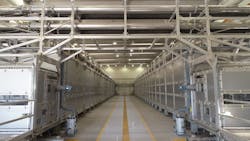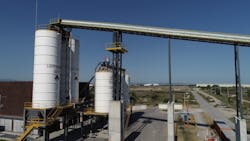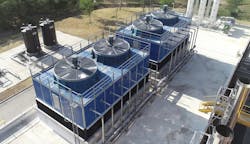Thermal Drying Diverts Sludge & Opens Recovery Avenues
Lynne Bouchy is international business development manager, drying technologies for Suez Water Technologies & Solutions. Octavio Osorio Vázquez is general director of Bienes Residuales, S.A. de CV., a company of Bieeco. Bouchy can be reached at [email protected]. Vázquez can be reached at [email protected].
undefinedBuilt in 1996, the Dulces Nombres Wastewater Treatment Plant in Monterrey, Mexico, is operated by Servicios de Agua y Drenaje de Monterrey (SADM), which provides drinking water, sewage collection and treatment services to the Monterrey metropolitan area. At 7,500 liters per second it is one of the largest plants in Central and South America.
It treats wastewater with pre-treatment, primary settling, biological treatment (conventional aeration tanks) and disinfection. Primary and waste activated sludge then are thickened and subsequently anaerobically digested via a conventional mesophilic system and finally dewatered using belt presses to reach 22% dry solids (DS). Traditionally, dewatered sludge from Dulces Nombres was trucked to landfills for disposal, in compliance with Mexican regulations.
With a high amount of dewatered sludge to manage daily and landfill capacity in the region diminishing, SADM adopted a more sustainable and environmentally friendly sludge management program to divert dewatered sludge from landfills and recover resources from sludge. SADM then published a tender for the procurement and installation of a low temperature, sludge thermal drying plant for the wastewater treatment plant of Dulces Nombres, which was awarded to Comercializadora Jubileo S.A. de CV, a company of Bienes Ecológicos (Bieeco)—a Mexico-based engineering, procurement and construction firm specializing in sustainable technologies. After Bieeco completed a thorough review of the drying technologies market, the Evaporis LT sludge drying system was chosen for the plant.
Low-Temperature Sludge Treatment
A patented technology from Suez Water Technologies & Solutions, the Evaporis LT solution, is a low temperature belt dryer that uses low-grade waste heat or other fuels to dry waste solids in an energy efficient process. For the Dulces Nombres installation, Suez manufactured, supplied and installed two Evaporis LT low temperature belt dryer systems, including key ancillaries such as boilers, cooling towers, ultrafiltration (UF) units and pipework.
Commissioned and completed at the end of 2018, the Evaporis LT dryers are the first sludge thermal units installed in Mexico. These are largest low temperature sludge drying units that Suez has built to date. The system is designed to reduce the quantity of sludge produced at Dulces Nombres by 70%, significantly lowering sludge management costs. The total dryer capacity of the new installation is capable of processing 405 tons of dewatered sludge every day (147,825 tons per year), delivering an environmental benefit by diverting an equal amount from landfills.
Part of a suite of thermal drying solutions designed to reduce the volume and improve the quality of wastewater biosolids and allow a broad range of resource recovery options, the modular Evaporis LT sludge drying system operates on the principle of continued drying by hot air convection (65/80°C) in a closed tunnel for processing municipal sewage sludge, industrial wastewater sludge, and other types of industrial byproducts
or waste.
|
"Biosolids produced by the dryer system can be used as a quality fertilizer, a new material or an energy source." |
To ensure air passes through sludge during dryer, a feed module receives and forms the dewatered sludge into strands, which then are conveyed on an upper drying belt where circulating hot air through the belt allows water to be extracted and moisture is captured from the sludge. The pre-dried sludge then is distributed onto a lower belt, where drying is completed. At the end of the process, the dried product is discharged using a screw press. These dried granules are easy to handle, do not require any further conditioning, and can be used in that form for a range of beneficial purposes.
The dewatered cake at Dulces Nombres is conveyed to the drying installation on belts—one of which is as long as 127 meters—and into 2 silos of 300 cu meters each equipped with a rotating screw discharge system prior to feeding to the dryers. Each dryer at Dulces Nombres includes a drying capacity of 7,304 kg of water (kg H20) per hour, providing a nominal overall evaporation capacity of 14,608 kg H20 per hour for processing municipal anaerobically digested sludge of dryness greater than 22% DS.
The energy consumption of the system includes heat below 1 kWh per kg H2O, and power below 500 kWh per hour per dryer. Inside the dryer, heat exchangers use 90°C water to provide low temperature heat to the dryer that never exceeds 80°C. The relatively low hot water requirement for the heat exchangers allows for flexibility in the heat source used to produce water at
that temperature.
At Dulces Nombres, heat for the Evaporis LT drying system is supplied by three 8,600 kW pirotubular three-pass boilers, which can be powered by either natural gas or biogas. Currently, the Dulces Nombres boilers run on natural gas, but SADM plans incorporate biogas produced on site by the plant’s sludge anaerobic digestion process. Such a transition offers an environmental value since the heat that is necessary for drying would be produced by the sludge itself.
Process water required is provided from the Dulces Nombres treated effluent or potable water, which then undergoes additional treatment comprising of ring filters, ultrafiltration and softening.
The dried sludge granules then are conveyed using tube chain conveyors, which gently transport the product to three silos of 200 cu meters, inertized with nitrogen prior to being loaded in trucks through a discharge system, avoiding bridging and an alveolar valve.
Design Simplicity
The user-friendly design of the system drove Bieeco’s purchase decision of the Evaporis LT dryer. Featuring an automated process, the drying system can run 17 hours without the presence of staff on site and enables operation and maintenance regimes. With all fans and heat exchangers located inside the dryer itself, the belt dryer solution is compact, while providing easy access to key areas of the dryer. No back-mixing or pelletizing is needed and efficient indirect condensation keeps output streams such as air and condensate to a minimum, further simplifying the scheme and reducing cost for ancillaries.
Since the Evaporis LT dryer technology requires simple heat installations and fluids (standard 90ºC hot water heat stream), the system does not require specially trained personnel and is easy to manage for wastewater treatment plant teams. The advanced design of the Evaporis LT system provides enhanced air tightness and ensures that leaks are prevented—allowing control of both air movement and odor. The use of carefully selected materials and thermal bridge breaks ensures the unit is well insulated for a long lifetime of use.
Biosolids Program Opportunity
The Evaporis LT installation at Dulces Nombres provides new avenues for sludge management by transforming sludge waste that previously required disposal into a valuable resource that offers opportunities for beneficial reuse. Biosolids produced by the Evaporis LT dryer system can be used as a quality fertilizer, a new material or an energy source.
SADM is exploring several approaches for recycling biosolids, including using the recovered biosolids as an alternative fuel source in Mexico’s cement industry.



